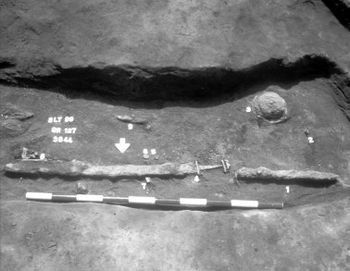Saltwood Tunnel (North of), ARC SLT 99
Canterbury Archaeological Trust, 2004. (updated 2017) https://doi.org/10.5284/1044753. How to cite using this DOI
Data copyright © High Speed 1 unless otherwise stated
This work is licensed under the ADS Terms of Use and Access.
Primary contact
Stuart
Foreman
Senior Project Manager
Oxford Archaeology (South)
Janus House
Osney Mead
Oxford
OX2 0ES
UK
Tel: 01865 263800
Fax: 01865 793496
Resource identifiers
- ADS Collection: 1838
- DOI:https://doi.org/10.5284/1044753
- How to cite using this DOI
Overview

The larger of the two barrow ditches was approximately 43 metres in diameter, the ditch being approximately 3.50m wide and 1.20m deep. A single crouch burial, complete with a pottery food vessel placed behind the skull, was located in the centre of the barrow. Provisional dating has suggested a Bronze Age date of 1800 BC. In comparison with the other graves excavated at Saltwood, bone preservation was good, with a virtually complete skeleton, though the bone was very soft. The burial was orientated North/South with the head facing east and the knees drawn up to the East.
A smaller barrow was located at the far west of the site, approximately 16 metres in diameter, the ditch being approximately 1.00m wide and 0.50m deep. No central burial was found for this barrow. A second crouch burial was located roughly halfway between the two barrows. This burial was oriented East-West, with the head facing upwards, the knees drawn up towards the South. There was no trace of any associated barrow ditch. No secure dating evidence was retrieved but it is thought to be of Bronze Age.
Iron Age activity was present in a series of intermittent but parallel ditches running North-West/South-East, representing the track-way identified in SLT 98.
The Anglo-Saxon cemetery consisted of 54 inhumations arranged in and around the southern limits of the large Bronze Age barrow. Forty-seven of these graves were orientated roughly east west with the remaining seven orientated roughly north south. Pen-annular ditches enclosed four of the East-west inhumations. The graves ranged from being very rich in grave goods to having no goods whatsoever. Many contained weapons, there were six swords, eight spearheads and three shield-bosses. There were twenty items provisionally identified as knives. Three glass beakers were present in the assemblage, two from grave 151, and one from grave 118. Various items of jewellery were recovered, including items such as a silver mounted rock crystal sphere, various silver and copper alloy brooches set with garnets and various semiprecious stones. The skeletal material was invariably in a very poor state of preservation, typically only portions of the larger long bones and partial crania survived. In many cases only teeth survived.
Later Medieval activity consisted of long stretches of drainage ditches and field boundaries. These had north-west by south-east and south-west by north-east orientation, and would appear to form a large rectangular based field system, the alignment and orientation of which appear to be similar to those identified during the earlier excavation to the west.






